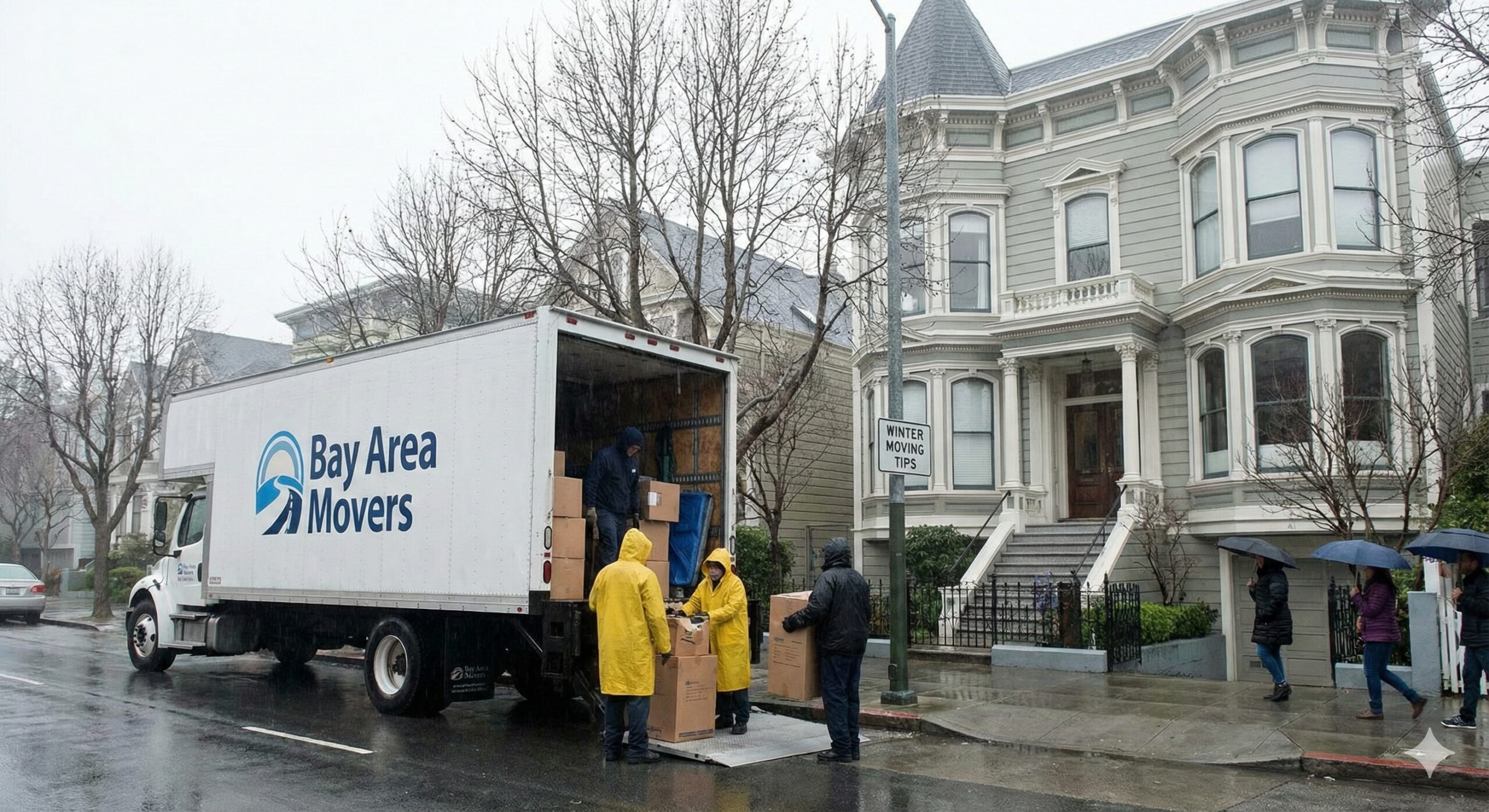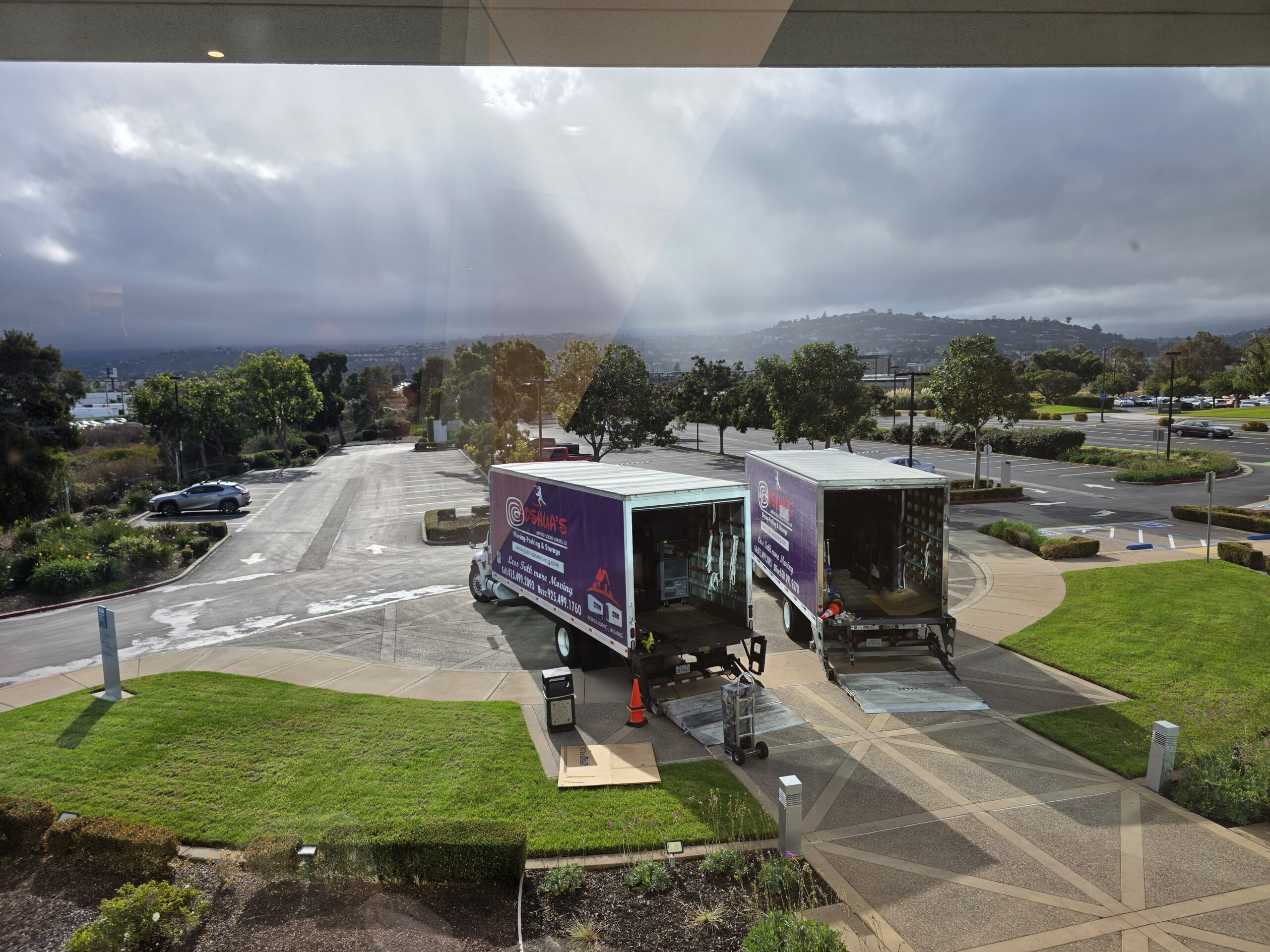If you’re planning moving in winter in the Bay Area, you’re choosing a season that comes with both surprising perks and a few weather-driven challenges. While the region doesn’t face snow or bitter cold, winter…

Moving in Winter in the Bay Area – Pros, Cons & Must-Know Tips
November 20, 2025
If you’re planning moving in winter in the Bay Area, you’re choosing a season that comes with both surprising perks and a few weather-driven challenges. While the region doesn’t face snow or bitter cold, winter does bring rain, fog, wet surfaces, and shorter days—all of which affect how smoothly a move goes.
This guide breaks down the pros, cons, and essential tips to help Bay Area homeowners, renters, and families prepare for a winter move across cities like Palo Alto, Mountain View, Redwood City, Menlo Park, San Mateo, and surrounding communities.
Understanding Bay Area Winter Weather
Mild temperatures but wet conditions
Compared to most of the country, Bay Area winters are relatively gentle. Highs usually land in the mid-50s to low-60s, and lows hover in the 40s. That means you won’t face frozen driveways or icy roads—but you will face moisture. Winter is the region’s rainiest season, and storms can roll in quickly.
Why local winter weather matters for moving
- Rain increases the risk of slippery walkways, soggy boxes, and water-damaged furniture.
- Shorter daylight hours create a tighter moving window.
- Damp mornings and fog can slow travel or loading.
- Cooler temperatures, however, make lifting boxes and furniture more comfortable than in summer heat.
Bay Area winter isn’t harsh—but it does require planning.
The Pros of Moving in Winter in the Bay Area
1. Lower demand and better mover availability
Winter is the slow season for most local movers. With fewer people scheduling relocations, you’ll usually experience:
- More open moving dates
- Better pick-your-time flexibility
- Less pressure to book months in advance
This flexibility is especially helpful if you’re moving in or out of busy areas like Palo Alto, Redwood City, or San Mateo.
2. Potentially lower moving costs
Because demand is lower, some movers offer more competitive pricing in the winter months. While not guaranteed, winter often brings:
- Occasional discounts
- Fewer peak-season rate increases
- More options to compare estimates
3. Easier access to building elevators and permits
Apartment buildings, condos, and HOAs often get backed up with reservation requests in summer. In winter:
- Elevator reservations are easier
- Loading zone permits (especially in Palo Alto or downtown San Mateo) are often quicker
- Property managers tend to have more availability to oversee move-ins
4. Cooler weather makes moving more comfortable
Carrying boxes in 55–60°F weather is dramatically easier than doing it during a 90°F heat wave. The cooler temps can reduce fatigue and make the overall moving day smoother for everyone involved.
5. A less hectic transition
Winter moves can feel calmer and more intentional. Relocating during a quieter season—especially early in the year—allows you to settle in without the rushed energy that summer moves often create.
The Cons of Moving in Winter in the Bay Area
1. Rain and moisture risk
The biggest downside is rain. Even a light drizzle can:
- Damage unprotected cardboard boxes
- Soak furniture and mattresses
- Create muddy walkways
- Make floors slippery and potentially unsafe
Moisture protection is essential during a winter move.
2. Shorter daylight hours
By December, the sun can set as early as 4:50 p.m. Less daylight means:
- Earlier start times are necessary
- Moves can feel rushed
- Unloading in the dark is harder, especially in neighborhoods with limited street lighting
Adjusting the schedule is key for winter timing.
3. Traffic challenges during winter storms
While the Bay Area doesn’t deal with snow, winter rainstorms can still slow traffic on:
- Highway 101
- I-280
- El Camino Real
- Residential roads with puddling or poor drainage
Storm days may require a buffer for delays.
4. Parking complications on wet streets
Rainy streets, fallen leaves, and narrow driveways can make maneuvering a large moving truck trickier. Securing nearby parking becomes even more important in neighborhoods like Menlo Park or downtown Mountain View.
5. Weather-related rescheduling
Heavy rain sometimes leads to:
- Slower loading/unloading
- Rescheduled move times
- Extra preparation or protective coverings
While most local movers work in the rain, flexibility helps avoid stress.
Must-Know Winter Moving Tips for Bay Area Residents
1. Protect belongings from moisture
Rain protection is your number-one priority. Use:
- Plastic wrap around upholstered furniture
- Mattress bags
- Waterproof bin lids or plastic sheeting over cardboard boxes
- Heavy-duty moving blankets
- Towels or mats at entryways to keep floors dry
Wood furniture, electronics, artwork, and books are especially sensitive to moisture.
2. Prep both homes for wet-weather moving
Before movers arrive:
- Clear leaves and debris from walkways
- Lay down non-slip runners or towels inside
- Use doormats to reduce slipping hazards
- Turn on porch lights if starting early or finishing late
At the new home, ensure the driveway and walkway are safe and well lit.
3. Start early—maximize daylight
In winter, the best moving window is often 7:00 a.m. to 2:30 p.m.
This allows enough light for loading, driving, and unloading without rushing at dusk.
4. Confirm parking and permits ahead of time
Cities like Palo Alto, Redwood City, and San Mateo may require:
- Temporary “no parking” signage
- Street occupancy permits
- HOA approval for moving trucks
Winter is the easiest season to get these—but you still want to secure them early.
5. Pack a weather-proof essentials box
This should stay with you, not the moving truck. Include:
- Towels for wet shoes
- Extra socks and warm layers
- Umbrellas or rain jackets
- Snacks and a thermos of coffee or tea
- Chargers, keys, and important documents
- Basic cleaning supplies for unexpected mud or water
6. Watch the weather forecast—but stay flexible
Bay Area storms can shift quickly. If heavy rain is predicted for your exact move time, consider adjusting:
- Start time
- Loading strategy
- Move date (if your mover offers flexibility)
A good moving team will help you plan around the forecast.
7. Choose a mover experienced with winter conditions
During a winter move, expertise matters. A skilled local mover will bring:
- Waterproof covers
- Floor runners
- Tracking prevention mats
- Rain-safe loading techniques
- Contingency plans for storms
Local knowledge is especially valuable in hilly neighborhoods, narrow Peninsula streets, or areas with tricky parking.
City-Specific Winter Tips

Palo Alto
- Some neighborhoods require temporary parking permits for moving trucks.
- Be mindful of school traffic near Palo Alto High School and JLS during winter mornings.
- Older homes can have narrow driveways—measure truck clearance ahead of time.
San Mateo
- Downtown streets can get congested on rainy weekdays; earlier moves are best.
- Condos along El Camino Real may require elevator reservations.
- Many complexes have covered loading zones—plan to use them.
Redwood City
- Redwood Shores can get windy; secure items tightly when loading outdoors.
- Some HOA communities have strict move-in windows—confirm in advance in winter months.
Mountain View
- Castro Street area can be busy during lunch hours even in winter; aim to unload before noon.
- Apartment buildings often require checking in with management before move day.
These small details can make a big difference on wet roads or tight timelines.
Should You Hire Professional Movers for a Winter Move?
You don’t need to, people perform DIY moves in winter all the time.
However, winter weather introduces extra variables that pros manage effortlessly.
Professional movers can:
- Protect belongings with waterproof wrap and tarps
- Keep floors dry and safe
- Load/unload quickly in light rain
- Handle parking logistics in busy city areas
- Plan around storm forecasts
- Keep your belongings dry from truck to home
If you’re relocating within Palo Alto or the Peninsula, a local crew who knows the neighborhoods and winter patterns can make the day smoother and lower the risk of costly damage.
To learn more about local services, visit:
Joshua’s Moving Services
To get pricing or check availability:
Request an Online Estimate
Conclusion
Moving in winter in the Bay Area comes with real advantages—more flexible scheduling, less competition for movers, and comfortable temperatures for heavy lifting. Rain and shorter daylight hours do introduce extra challenges, but with a little preparation, the right supplies, and knowledgeable local movers, a winter move can be one of the smoothest times to relocate.
Whether you’re transitioning to a new job, upgrading to a larger home, or settling into a new neighborhood, winter can be an ideal time to make the move.
Need help planning your winter move? Joshua’s Moving is here to make the process easy. Get a free estimate in minutes.
Authored By:

